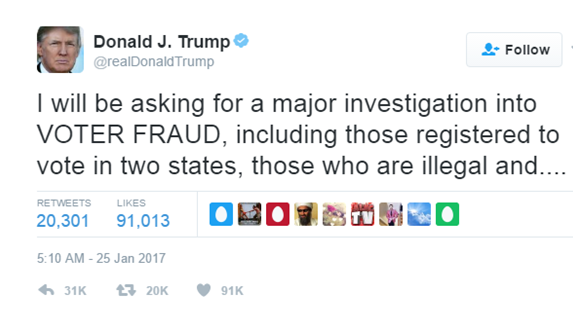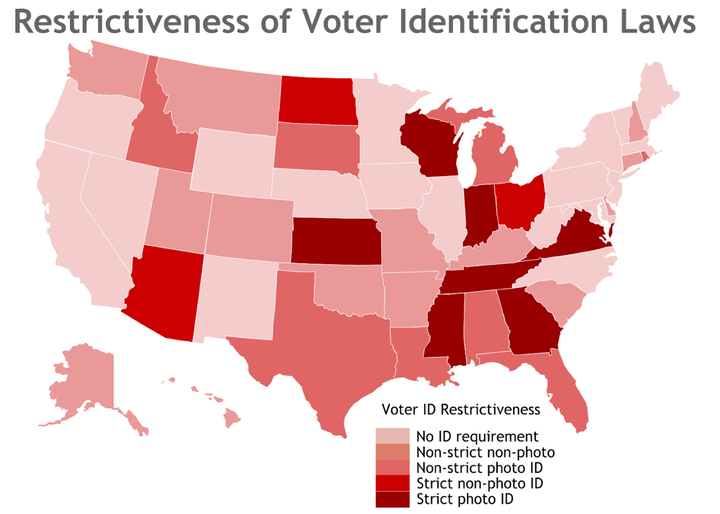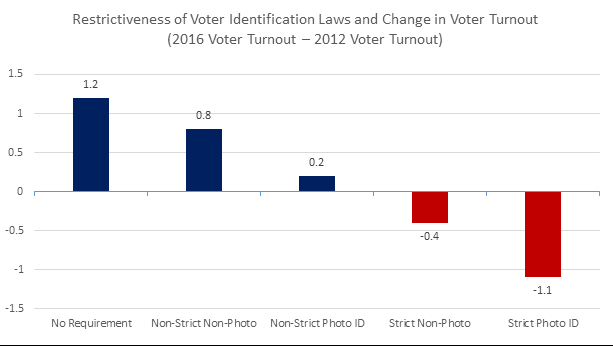President Donald Trump surprised congressional leaders last Monday (January 23) by declaring that widespread voter fraud was to blame for his popular vote loss in the 2016 election. He made no attempt to provide supporting evidence for his claim that “3-5 million illegals” voted for Hillary Clinton, instead demanding “a major investigation into VOTER FRAUD.” He subsequently pointed to a tweet based on an unreleased “study” no one has been able to read or verify. Perhaps with intended irony, the source of that tweet, Gregg Phillips, responded to requests to see the data as follows: “We will release it in open form to the American people. We won’t allow the media to spin this first.”

For most observers, this is yet another sign of Trump’s pathological insecurities about the legitimacy of his electoral college victory. We would suggest there may be a method to the madness. As one of us noted in an earlier post, claims of rigged elections and biased media served to mobilize likely Republican voters while demobilizing likely Democrats.
More generally, claims of voter fraud are rarely about voter fraud but are strategically directed at demobilizing voter turnout via legal restrictions crafted to make voting more difficult or to create confusion about the voting process. These efforts are neither isolated incidents nor or they without consequence. Throughout our history, election laws have been manipulated to restrict voter eligibility, access, and impact. Seldom have lawmakers expressed their intentions outright; instead they impose restrictions under the guise of protecting the integrity of the system.

In recent research, we investigated two enduring voter suppression tactics: felon disenfranchisement and voter identification laws. We found that states which disenfranchise larger percentages of their population via felony convictions are also more likely to have restrictive voter identification requirements.

Second, the effect of these laws extends beyond affected individuals. Friends, families, neighbors, and even entire communities are affected. By adding uncertainty to the voting calculus, restrictive state laws can decrease participation rates more generally and especially among poorer, less educated, and minority populations.
More generally, misinformation and misunderstanding tacitly suppress political behavior. Research into the consequences of felon disenfranchisement laws, for example, finds that unaffected individuals (those convicted of crimes but eligible to vote) often believe, incorrectly, that they are ineligible. Exaggerated and unsubstantiated claims of voter fraud can independently drive down voter participation rates while also laying the groundwork for future restrictions. As previous research has shown, questioning the integrity of the electoral system can drive down voter turnout.
In 2016, the added uncertainty of voter identification laws adversely affected turnout in those states with the most restrictive identification requirements. We illustrate this relationship in Figure 1. States with more restrictive voter identification laws saw turnout decrease in 2016 (relative to 2012). States with less restrictive laws, in contrast, saw voter turnout increase. The effects here are not particularly large. Although the impact is small, it is real. Trump won the electoral college with fewer than a collective 80,000 votes in three states.

We should also acknowledge that this relationship is likely context dependent. In 2012, with Barack Obama running for reelection, voter identification laws may have had little or no effect on voter participation. Indeed, the initial passage of the laws may have had a backlash effect, encouraging voters to turnout because of what they perceived as efforts at voter suppression. In general, we know that voter participation rates are not merely a function of legal restrictions but also reflect a host of other factors related to the election, including the competitiveness of the election, the charisma of the candidates, and the clarity of the choice confronting voters. Regardless, at least in some electoral context, legal restrictions may disproportionately drive down voter turnout.
Whether President Trump’s recent efforts to raise the specter of voter fraud translate into new legal restrictions may well depend on the courts. Perhaps coincidentally, the same day President Trump called for an investigation into voter fraud, the Supreme Court rejected Texas’ appeal to restore its voter identification law. Separately and independently, the 4th and 5th Circuit Court of Appeals had earlier (in July 2016) ruled against restrictive voter identification laws in North Carolina and Texas, with the 4th Circuit explicitly noting the North Carolina law “target[ed] African American voters with almost surgical precision.” While it may be tempting to think the issue is dead, in denying writ of certiorari Chief Justice Roberts invited Texas to raise the issue again. One can reasonably speculate that next time around President Trump will align the federal government and the Department of Justice with Texas and other states seeking to restrict voter turnout.
In the end, making fictitious claims of voter fraud may seem baffling if your real concern is voter fraud. It seems less perplexing if the goal is to add confusion and uncertainty to the voting process, adversely affecting voter turnout in future election cycles. The effects may be small, but in a close election they can be nontrivial. Having already filed his paper work for 2020, President Trump may already be looking ahead to an election where small differences at the margin make a big difference in the electoral college.